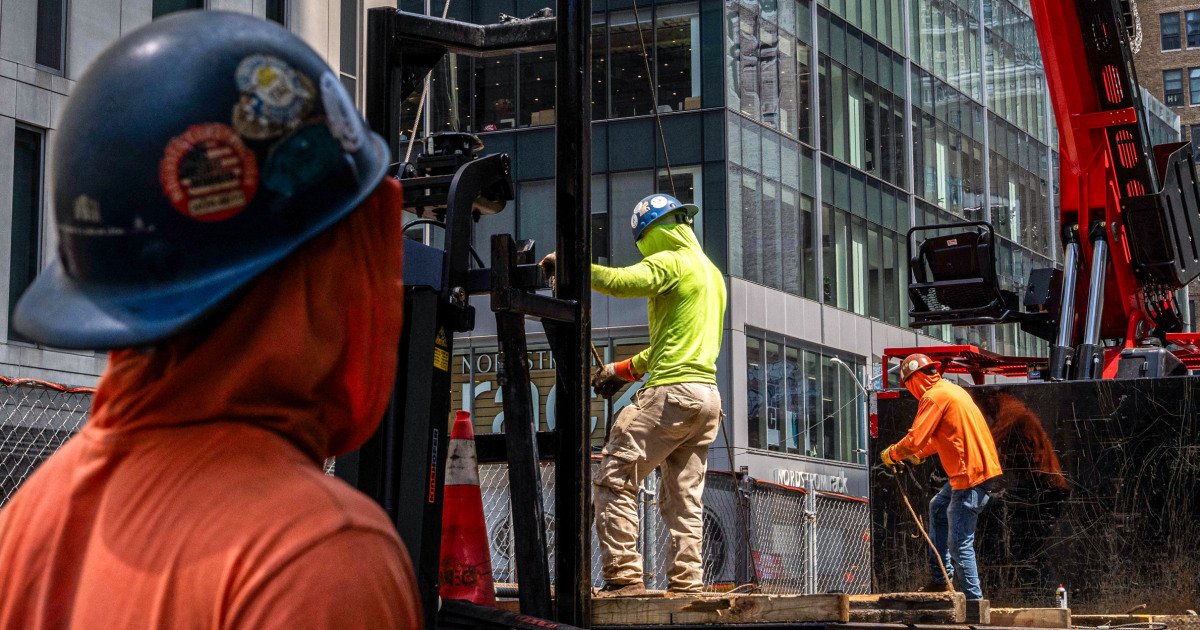Profile
Sections
Local
tv
Featured
More From NBC
Follow NBC News
news Alerts
There are no new alerts at this time
The U.S. added 147,000 jobs in June, soundly beating estimates and offering a welcome sign that the economy remains in relatively solid shape.
The unemployment rate fell to 4.1%, from 4.2%, the Bureau of Labor Statistics reported Thursday. The job gains for April and May were revised up by a combined 16,000.
June’s increases were led by roles in state and local government education, which added 63,500 positions, with state and local roles overall accounting for half of all job gains for the month. Health care and social assistance added another 58,600, while leisure and hospitality grew by 20,000 and construction gained 15,000.
Employment declined in the federal government, professional services and manufacturing.
Yet there are also signs that it remains difficult for those who’ve been out of work to land a job. The number of long-term unemployed people increased by 190,000 to 1.6 million, largely offsetting a decrease in the prior month.
The median and average unemployment duration climbed back to near pandemic-era highs, with the share of those out of work for 15 weeks or more jumping to 38.3%, from 34.9%, reversing a downtrend over the last six months.
“For job seekers outside of healthcare & social assistance, local government, and public education, the gains will likely ring hollow,” Cory Stahle, Indeed Hiring Lab economist, wrote in a note following the report’s release.
“Employment growth outside of those marquee industries has been anemic at best, and the duration of unemployment for the typical unemployed worker seeking a job continues to creep up. This is not a bad report, but it might not be as solid as it seems on the surface.”
The S&P 500 rose to a new record in early trading even as investors dialed back the odds of an interest rate cut in July by the Federal Reserve, something President Donald Trump has continued to call for.
Consumers and businesses are still grappling with the uncertainty caused by Trump’s tariff policies, which are contributing to volatile economic data.
On one hand, the inflation rate has so far proven stable, while average earnings continue to grow at a healthy clip. Stocks have returned to all-time highs, and in testimony last week, Federal Reserve Chair Jerome Powell described overall economic conditions as “solid.”
“Look at labor force participation, look at wages, look at job creation,” Powell said. “They’re all at healthy levels now. I would say you can see perhaps a very, very slow continued cooling but nothing that’s troubling at this time.”
On the other hand, Powell’s assertions have not sat well with Trump, who has continued to harangue him to lower interest rates. On Wednesday evening, the president said Powell should “resign immediately.”
Commentary from U.S. firms and various other data points paint a more worrisome portrait of the economy. The latest survey of manufacturers from the Institute for Supply Chain Management found some firms describing the business environment as “hellacious” and “too volatile” to make long-term procurement decisions.
On Wednesday, the private payrolls processor ADP reported a net decline in jobs added, which hasn’t occurred since March 2023 — and before that, the depths of the Covid-19 pandemic. The May figure was revised even lower, to just 29,000 jobs added, from 37,000.
“Though layoffs continue to be rare, a hesitancy to hire and a reluctance to replace departing workers led to job losses last month,” Nela Richardson, ADP’s chief economist, said in a statement Wednesday morning.
Clarity about tariffs has been set to arrive by next week, with Trump earmarking July 9 as his deadline to negotiate new trade deals. While he said this week that he doesn’t plan to extend it, White House officials have more recently indicated that key date is “not critical.”
Meanwhile, Republicans continue to debate Trump’s tax cut and spending bill in Congress even as it has cleared some key hurdles.
“Companies need business visibility in taxes and policy if they are going to take the risk of hiring a new employee,” Peter Boockvar, chief investment officer of Bleakley Financial Group, wrote in a note to clients. “And tariffs, on again/off again, have just thrown mud into the gears of business activity.”
An additional hiring report released this week by the job consultancy Challenger, Gray and Christmas showed that through June, U.S. employers have announced 82,932 planned hires, a 19% increase over the 69,920 announced at this point in 2024.
Yet that rate remains historically low, it said.
“Hiring announcements in 2025 suggest a cautious but stabilizing labor market,” Senior Vice President Andrew Challenger said in a release. “While companies are clearly adding workers at a higher rate than in 2024, the restraint shown relative to previous years indicates continued uncertainty around costs, automation, and the broader economic outlook. Without a strong economic driver, hiring may remain measured through the rest of the year.”
Rob Wile is a Pulitzer Prize-winning journalist covering breaking business stories for NBCNews.com.
© 2025 NBCUniversal Media, LLC
The U.S. added 147,000 jobs in June, relieving some concerns of a workforce slowdown – NBC News



